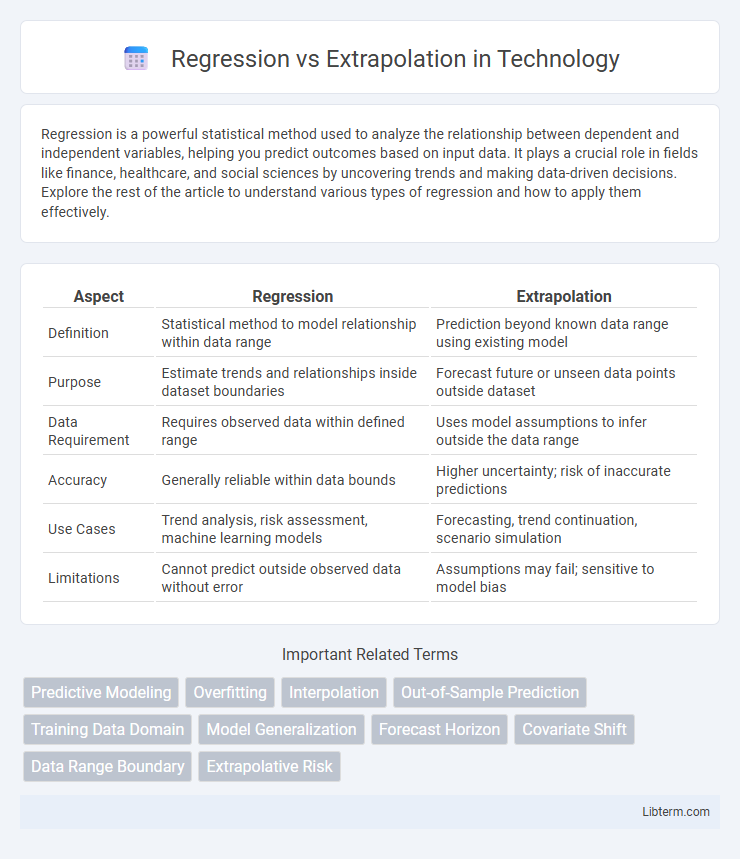Regression is a powerful statistical method used to analyze the relationship between dependent and independent variables, helping you predict outcomes based on input data. It plays a crucial role in fields like finance, healthcare, and social sciences by uncovering trends and making data-driven decisions. Explore the rest of the article to understand various types of regression and how to apply them effectively.
Table of Comparison
| Aspect | Regression | Extrapolation |
|---|---|---|
| Definition | Statistical method to model relationship within data range | Prediction beyond known data range using existing model |
| Purpose | Estimate trends and relationships inside dataset boundaries | Forecast future or unseen data points outside dataset |
| Data Requirement | Requires observed data within defined range | Uses model assumptions to infer outside the data range |
| Accuracy | Generally reliable within data bounds | Higher uncertainty; risk of inaccurate predictions |
| Use Cases | Trend analysis, risk assessment, machine learning models | Forecasting, trend continuation, scenario simulation |
| Limitations | Cannot predict outside observed data without error | Assumptions may fail; sensitive to model bias |
Introduction to Regression and Extrapolation
Regression refers to statistical methods used to model and analyze the relationship between dependent and independent variables, aiming to predict outcomes within the range of observed data. Extrapolation involves extending the regression model beyond the observed data range to predict values outside the known dataset, which carries increased uncertainty and risk of error. Understanding the distinction between interpolation within regression boundaries and extrapolation beyond these limits is crucial for accurate and reliable predictive analytics.
Defining Regression Analysis
Regression analysis is a statistical method used to examine the relationship between dependent and independent variables, enabling predictions within the scope of observed data. It models the underlying trend by fitting a function, often linear, to the existing dataset to estimate unknown values accurately. Unlike extrapolation, regression analysis is constrained to interpolation, where predictions remain valid within the range of the original data points.
What is Extrapolation?
Extrapolation predicts values beyond the range of observed data by extending trends identified through regression analysis. It assumes that existing patterns continue outside the known dataset, which can lead to increased uncertainty and potential inaccuracies. Accurate extrapolation relies on the stability of underlying relationships and careful consideration of external factors affecting the modeled variable.
Key Differences Between Regression and Extrapolation
Regression involves creating a predictive model based on existing data points within a known range, emphasizing interpolation for estimating values between observed data. Extrapolation extends beyond the original data range, predicting outcomes outside the observed dataset, which increases uncertainty and potential error. Key differences include the reliability of predictions, with regression generally providing more accurate estimates within the data boundaries, while extrapolation involves higher risk due to assumptions about trends continuing beyond known data.
Methods Used in Regression
Regression employs methods such as least squares estimation, gradient descent, and maximum likelihood estimation to model the relationship between dependent and independent variables based on observed data. Techniques like linear regression, polynomial regression, and ridge regression optimize parameters to minimize prediction error within the range of the training data. These methods focus on interpolation within the domain of available data, contrasting with extrapolation, which estimates values outside this range and typically involves greater uncertainty.
Types of Extrapolation Techniques
Types of extrapolation techniques include linear extrapolation, which extends a trend line beyond known data points assuming a constant rate of change; polynomial extrapolation, using higher-degree polynomials to model more complex patterns; and spline extrapolation, which employs piecewise polynomials for smoother transitions between data segments. Other advanced methods involve logarithmic and exponential extrapolation, useful for data exhibiting growth or decay rates. The choice of extrapolation technique depends on data behavior, model complexity, and the desired prediction accuracy.
Applications of Regression in Real-World Scenarios
Regression analysis plays a crucial role in forecasting sales trends, risk assessment in finance, and predicting patient outcomes in healthcare. By modeling relationships between variables, regression enables businesses to optimize marketing strategies and engineers to enhance product reliability. Real-world applications of regression extend to climate modeling and economic policy simulations, where accurate predictions influence critical decision-making processes.
Risks and Limitations of Extrapolation
Extrapolation carries significant risks because it extends predictions beyond the observed data range, often leading to inaccurate or unreliable results due to unknown variable interactions. Unlike regression, which fits a model within the scope of existing data, extrapolation assumes that observed trends continue unchanged, ignoring potential nonlinearities or external factors. This limitation can result in erroneous conclusions, making careful validation and domain knowledge crucial when interpreting extrapolated outcomes.
When to Use Regression vs. Extrapolation
Use regression when analyzing data within the range of observed values to model relationships and make accurate predictions based on existing patterns. Employ extrapolation cautiously when estimating values beyond the observed data range, as predictions may become unreliable due to increased uncertainty and potential changes in underlying trends. Opt for regression to understand trends and correlations within known parameters, while reserving extrapolation for exploratory forecasting with careful consideration of risks.
Conclusion: Choosing the Right Approach
Selecting between regression and extrapolation depends on the available data range and the prediction goal. Regression fits models within the observed data to identify trends accurately, while extrapolation extends predictions beyond known values but carries higher uncertainty and risk of error. For reliable forecasting, prioritize regression when working within data limits, reserving extrapolation for exploratory analysis with cautious interpretation.
Regression Infographic

 libterm.com
libterm.com